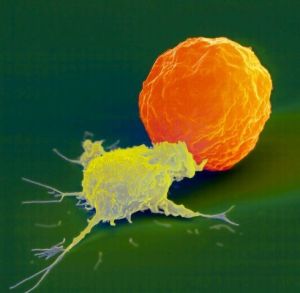Natural killer cell
Natural killer cells (NK) : are a type of lymphocyte : innate immune system.
NK cells play a major role in the host-rejection of both tumours and virally infected cells.
NK cells are cytotoxic; small granules in their cytoplasm contain special proteins such as perforin and proteases known as granzymes.
: release in close to a cell for killing, perforin forms pores in the cell membrane of the target cell : the granzymes can enter and apoptosis.
NK are activated in response to interferons or macrophage-derived cytokines.
Patients deficient in NK cells prove to be highly susceptible to early phases of herpes virus infection.


Natural killer cell deficiency
:inherited immune system disorder, patient has low or absent levels of a certain type of NK cells.
: five different genes have been shown to cause NK cell deficiency. Each of these genes is passed down as an autosomal recessive trait.
these patients are vulnerable to infections.
suffer from frequent infections, especially lung infections and herpes virus infections
Life expectancy :depending on how severe the deficiency.
The condition may lead to fatal infections and increased of developing cancer.
Diagnosis:
DNA analysis
Natural killer cell count
Treatment:
no specific treatment for natural killer (NK) cell deficiency. Treatment focuses on curing infections associated with the disorder.





